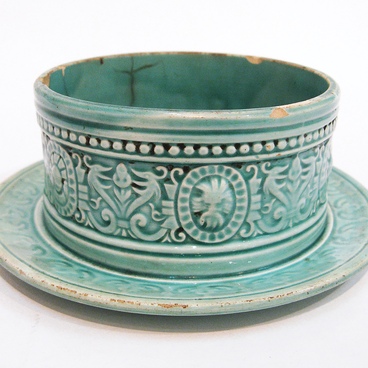The collection of the Kótlas Museum includes this rectangular tin box with rounded corners and a hinged lid. The box shows views of Moscow. It is decorated with images of the Bolshói Theater in Moscow, the Cathedral of Christ the Savior, the Arc de Triomphe, and the shopping center. On the lid is a view of the Kremlin. Under the top cover is a printed table of the current cost (‘“Preis-Courant “) of tea in bulk versus by the box. The manufacturers are David Vysótsky and Raphael Gotz in Moscow and Odessa, respectively.
Drinking tea in large quantities in Russia began in the 19th century. Two-thirds of the import of tea came from long-leaf loose tea, and a third from pressed bricks of powder. Long-leaf loose tea was in demand in Central Russia, and the compressed bricks became more widespread in Central Asia and Siberia. By the end of the 19th century, tea had become a popular commodity.
Drinking tea in large quantities in Russia began in the 19th century. Two-thirds of the import of tea came from long-leaf loose tea, and a third from pressed bricks of powder. Long-leaf loose tea was in demand in Central Russia, and the compressed bricks became more widespread in Central Asia and Siberia. By the end of the 19th century, tea had become a popular commodity.
One of the most famous tea merchants in Russia was the Vysótsky dynasty. The company opened branches in Russia and abroad, and its own tea-packing factories in Moscow, St. Petersburg, Chelyábinsk, Odessa, Kókand and Sreténsk. The Vysótsky factories were considered some of the most advanced and technically equipped. The number of workers in factories reached 22 thousand people. The level of social security at the enterprises was unusually high by the standards of that time - the company maintained hostels, baths, hospitals, medical centers, and savings and loan banks were created for employees.
In 1904, a representative office of the Vysótskys was opened in New York, and in 1907 a branch opened in London. In 1913, the leadership established a charitable society in Berlin, which financed the training of poor Russian and foreign Jewish technical students in Palestine. In 1913, Vysótsky & Co., with its main warehouses in Moscow, Odessa, Chelyabinsk and Nízhny Novgorod, expanded its network of retail establishments throughout Russia.
However, the life of the empire was interrupted by the First World War. The owners of Vysótsky and Co. transferred large sums of money for military needs, at the disposal of the Moscow Exchange Committee and the Moscow Jewish Society for Aid to the Wounded and Sick Soldiers. An infirmary was organized at the Moscow tea-packing factory. The October Revolution ended the history of the Vysótsky tea company in Russia. In 1918, all branches and tea-packing factories were nationalized.
However, Vysótsky & Co. was the only Russian tea company that managed to continue its business, transferring management to London, preserving capital and its foreign branches. The firm later moved to Palestine and eventually settled in Israel.
In 1904, a representative office of the Vysótskys was opened in New York, and in 1907 a branch opened in London. In 1913, the leadership established a charitable society in Berlin, which financed the training of poor Russian and foreign Jewish technical students in Palestine. In 1913, Vysótsky & Co., with its main warehouses in Moscow, Odessa, Chelyabinsk and Nízhny Novgorod, expanded its network of retail establishments throughout Russia.
However, the life of the empire was interrupted by the First World War. The owners of Vysótsky and Co. transferred large sums of money for military needs, at the disposal of the Moscow Exchange Committee and the Moscow Jewish Society for Aid to the Wounded and Sick Soldiers. An infirmary was organized at the Moscow tea-packing factory. The October Revolution ended the history of the Vysótsky tea company in Russia. In 1918, all branches and tea-packing factories were nationalized.
However, Vysótsky & Co. was the only Russian tea company that managed to continue its business, transferring management to London, preserving capital and its foreign branches. The firm later moved to Palestine and eventually settled in Israel.

